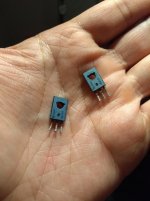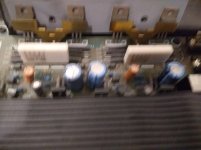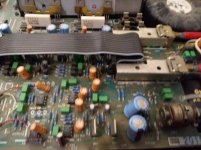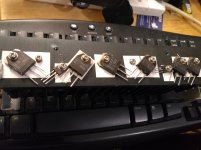I have fantastic news....for me 
I have an old Rotel amp that failed probably driver or pre section, tried to fix with help of this forum many years ago but completely failed and abandoned
I not only managed to find working D1047's but also one pair of used (god knows where I got them from) MJE transistors for drive section!! There are 8 D1047's 4 of them should be working at least and the MJE works as I just tested them, they didn't beep gave me like 720 result on both legs. Have no idea what that means but from what I read it should be ok. As long as I didn't blow the other channel powering it up I have everything I need right here!
gave me like 720 result on both legs. Have no idea what that means but from what I read it should be ok. As long as I didn't blow the other channel powering it up I have everything I need right here!
I really hope I'm right about all this. Any advice appreciated.
I have an old Rotel amp that failed probably driver or pre section, tried to fix with help of this forum many years ago but completely failed and abandoned
I not only managed to find working D1047's but also one pair of used (god knows where I got them from) MJE transistors for drive section!! There are 8 D1047's 4 of them should be working at least and the MJE works as I just tested them, they didn't beep
I really hope I'm right about all this. Any advice appreciated.
Attachments
Original BUV28 transistors are only a TO220 size package and I think we are aware, just by catalogue illustrations, what that looks like but the recommended replacement type is TO218, now TO247 size, as fitted in later models. Look again at the pics of Cyrus 1 and 2 at Paul Kemble's site. Notice the different size power transistors? Pin spacings are doubled too. You can always use your browser to check the package type in seller's catalogues if you can't find datasheets with the specifications.
HTTP 301 This page has been moved
http://www.st.com/resource/en/datasheet/buv48a.pdf
If you want to fit typical modern audio power transistors instead, you'll find most are actually larger again, in TO3P or TO264 (TO3PL) packages.
Semis are cheaper than they have ever been. In the scheme of new amplifier prices, ₤2 per power transistor is insignificant. Unfortunately, new parts prices are keyed to sales volumes and competition, not the asking price for used equipment.
As advised earlier, I would not plan to use those TO3P sized 2SD1047 types even if they can be squeezed in, BTW. Since you can't source the original size and type transistors, it occurs to me that Naim used NA005 (a house code) switching transistors in all their Nait series integrated amps, incuding NAP90. These were TO220 size, similar to BD743, now replaced by BD911. The latter are really tough and probably one of the few T0220 sized transistors that will be up to the task, provided you use correct thin mica/white grease mounting insulation. (Some cheapo mica washers are sliced like slabs, 5 times thicker than they should be).
HTTP 301 This page has been moved
http://www.st.com/resource/en/datasheet/buv48a.pdf
If you want to fit typical modern audio power transistors instead, you'll find most are actually larger again, in TO3P or TO264 (TO3PL) packages.
Semis are cheaper than they have ever been. In the scheme of new amplifier prices, ₤2 per power transistor is insignificant. Unfortunately, new parts prices are keyed to sales volumes and competition, not the asking price for used equipment.
As advised earlier, I would not plan to use those TO3P sized 2SD1047 types even if they can be squeezed in, BTW. Since you can't source the original size and type transistors, it occurs to me that Naim used NA005 (a house code) switching transistors in all their Nait series integrated amps, incuding NAP90. These were TO220 size, similar to BD743, now replaced by BD911. The latter are really tough and probably one of the few T0220 sized transistors that will be up to the task, provided you use correct thin mica/white grease mounting insulation. (Some cheapo mica washers are sliced like slabs, 5 times thicker than they should be).
Last edited:
I hate not having the amplifier in front of me! I will take it out of the bedroom and have it ready for tomorrow nights tinkering  As the famous saying goes if fits , I sits lol for me cost is an issue. 4 x new transistors = £10+ and drivers £5+ and new caps perhaps = £ infinity! and waiting for delivery. I have CPU paste here and maybe thermal pads that fits. At least if I can check it works fine I can give it to a mate, he can finish it off.
As the famous saying goes if fits , I sits lol for me cost is an issue. 4 x new transistors = £10+ and drivers £5+ and new caps perhaps = £ infinity! and waiting for delivery. I have CPU paste here and maybe thermal pads that fits. At least if I can check it works fine I can give it to a mate, he can finish it off.
I'm a bit confused now Ian are you saying I can use BD911? Instead of D1047? If so why are all these transistors compatible? I thought you couldn't do things like that!?!
I'm a bit confused now Ian are you saying I can use BD911? Instead of D1047? If so why are all these transistors compatible? I thought you couldn't do things like that!?!
Your PCB will be drilled for TO220 spacing, same as the drivers in your pic - that's tiny! The legs on larger transistors can be carefully crooked to a narrower spacing too but only with some types that also have narrow pins. A lot of recent power transistor manufactures seem to have very wide pins which may fracture if tortured to get the device low enough to the PCB to clamp correctly at the point where the heat spreader on the rear is evenly clamped to the heatsink. Well, I'm just saying that they'll sit too high off the PCB.
I'm suggesting a rethink, depending on the actual part dimensions. I've already emphasised that the original transistor type is a power switching transistor and that is the characteristic you'll see on datasheet headlines if you read them. That brings to mind other switching TO220 switching types like BD911 or MJE13009, FJ13009 etc. which I've also seen as replacements in Naits, since only Naim agents can access original factory spec. and probably matched parts.
Historically, UK designers steered their own course toward switching type power transistors for better crossover performance in class AB operation. It was Japanese expertise that brought the modern audio power transistors to the fore and now they are universal but not so until well after this amp. was designed. It means that maxim's about only using special audio transistors only apply to certain manufacturers and eras.
I wasn't aware that that both those tough drivers had also blown. That must have been one mighty blowout and I'd suspect more than just the output stage was damaged.
I doubt your forum source was talking of lower distortion meaning measured distortion. Perhaps it's a subjective assessment based on a memory of how the amplifier sounded earlier? In any case, the suggestions seem to say that any cheap power transistor in a TO220 case is OK to use. Well, they may work, but I suggest not using a slug like MJE3055 if you expect better than passable audio. Use types with at least similar characteristics if you can't afford the appropriate ones.
Don't use silicone rubber washers or CPU grease - its often conductive to some degree, regardless of claims and you need mica for maximum heat conduction with small transistors. Just consider that if you are on a tight budget and make one slip-up, you have nothing left but another box to stow somewhere
I'm suggesting a rethink, depending on the actual part dimensions. I've already emphasised that the original transistor type is a power switching transistor and that is the characteristic you'll see on datasheet headlines if you read them. That brings to mind other switching TO220 switching types like BD911 or MJE13009, FJ13009 etc. which I've also seen as replacements in Naits, since only Naim agents can access original factory spec. and probably matched parts.
Historically, UK designers steered their own course toward switching type power transistors for better crossover performance in class AB operation. It was Japanese expertise that brought the modern audio power transistors to the fore and now they are universal but not so until well after this amp. was designed. It means that maxim's about only using special audio transistors only apply to certain manufacturers and eras.
I wasn't aware that that both those tough drivers had also blown. That must have been one mighty blowout and I'd suspect more than just the output stage was damaged.
I doubt your forum source was talking of lower distortion meaning measured distortion. Perhaps it's a subjective assessment based on a memory of how the amplifier sounded earlier? In any case, the suggestions seem to say that any cheap power transistor in a TO220 case is OK to use. Well, they may work, but I suggest not using a slug like MJE3055 if you expect better than passable audio. Use types with at least similar characteristics if you can't afford the appropriate ones.
Don't use silicone rubber washers or CPU grease - its often conductive to some degree, regardless of claims and you need mica for maximum heat conduction with small transistors. Just consider that if you are on a tight budget and make one slip-up, you have nothing left but another box to stow somewhere
I'd like to add that for a TO-220, the On-Semi MJE15032 is rated at 8 amperes and should work well in that amplifier. The 2N6488 is another tough transistor in TO-220 that should also work well and is rated for 15 amperes.
I hate to mention it, but your amplifier is damaged enough to really need an experienced tech to work on it.
I hate to mention it, but your amplifier is damaged enough to really need an experienced tech to work on it.
I'm going to find all transistors I have 4 of and if someone can advise what is best for sound it would be greaaaaatly appreciated!
I know for a fact I have the below and will add to the list:
D1047
2SC5359 - Suitable for use in 100-W high fidelity audio amplifier’s output stage
I know for a fact I have the below and will add to the list:
D1047
2SC5359 - Suitable for use in 100-W high fidelity audio amplifier’s output stage
I got it!!
After inspection I check the external fuse and it was blown. After replacing it it blew again. After replacing it with a higher wattage fuse because that's all I had it blew the internal fuses.
That is definitely advanced technician fault finding mode you were working in
Far better to start at the other extreme. USE A BULB TESTER
This thread should have it all covered:
cyrus 1 output transistor question. push-pull?
.That is definitely advanced technician fault finding mode you were working inKeep increasing the value of the fuses until the actual fault makes it presence felt by components exploding or catching fire
My feelings.....they are hurting!
That link is 28 pages!?!?!? OK I will read through it tonight
Watch that Ft isn't too high!
-Chris
what does that mean. I did just search that and it says 30. I think the D1047 said 20. Why should it be not so high?
Hi dj_holmes,
Ft is typically expressed in MHz, so outputs may have an Ft anywhere from 1 MHz to 30 MHz, maybe more for some new devices. If the replacement device has a higher high frequency response than the original, you will probably have to compensate the amplifier to stop it from oscillating. That means changing some feedback capacitors most commonly. You definitely need an oscilloscope for amplifier work, and aside from a THD analyser, you need both a low distortion oscillator and it helps to have a fast pulse / square wave generator.
At your current level of experience, you most certainly do not want to have to stop an amplifier from oscillating. Oscillation can burn out tweeters, overheat the outputs and increase distortion (or maybe reduce it in some cases). Either way, it is a decidedly negative thing to have to deal with.
It takes many years for a technician to become good, decades for most. I'm a far better technician now at 59 years old than I was at 20 (I wasn't bad then, better than average I'm told). Experience is a hard teacher, but a good one. It really helps to have guidance and I'm grateful for all those who gave me guidance over the years. You're taking the first steps now. You can't even be aware of all the things you don't know. A difficult position to be in. That's why there have been comments that suggest you're a little out of your depth with this one. These are not negative comments. Just an acknowledgement of fact. Proceed carefully and listen to some of the excellent advice that can be found here. We have some incredibly skilled members. Learn from them.
-Chris
Ft is typically expressed in MHz, so outputs may have an Ft anywhere from 1 MHz to 30 MHz, maybe more for some new devices. If the replacement device has a higher high frequency response than the original, you will probably have to compensate the amplifier to stop it from oscillating. That means changing some feedback capacitors most commonly. You definitely need an oscilloscope for amplifier work, and aside from a THD analyser, you need both a low distortion oscillator and it helps to have a fast pulse / square wave generator.
At your current level of experience, you most certainly do not want to have to stop an amplifier from oscillating. Oscillation can burn out tweeters, overheat the outputs and increase distortion (or maybe reduce it in some cases). Either way, it is a decidedly negative thing to have to deal with.
It takes many years for a technician to become good, decades for most. I'm a far better technician now at 59 years old than I was at 20 (I wasn't bad then, better than average I'm told). Experience is a hard teacher, but a good one. It really helps to have guidance and I'm grateful for all those who gave me guidance over the years. You're taking the first steps now. You can't even be aware of all the things you don't know. A difficult position to be in. That's why there have been comments that suggest you're a little out of your depth with this one. These are not negative comments. Just an acknowledgement of fact. Proceed carefully and listen to some of the excellent advice that can be found here. We have some incredibly skilled members. Learn from them.
-Chris
.
My feelings.....they are hurting!
That link is 28 pages!?!?!? OK I will read through it tonight
Well we did get a very successful outcome with that particular amp, and we also covered a lot of general good working practice.
Hi dj_holmes,
Ft is typically expressed in MHz, so outputs may have an Ft anywhere from 1 MHz to 30 MHz, maybe more for some new devices. If the replacement device has a higher high frequency response than the original, you will probably have to compensate the amplifier to stop it from oscillating. That means changing some feedback capacitors most commonly. You definitely need an oscilloscope for amplifier work, and aside from a THD analyser, you need both a low distortion oscillator and it helps to have a fast pulse / square wave generator.
At your current level of experience, you most certainly do not want to have to stop an amplifier from oscillating. Oscillation can burn out tweeters, overheat the outputs and increase distortion (or maybe reduce it in some cases). Either way, it is a decidedly negative thing to have to deal with.
It takes many years for a technician to become good, decades for most. I'm a far better technician now at 59 years old than I was at 20 (I wasn't bad then, better than average I'm told). Experience is a hard teacher, but a good one. It really helps to have guidance and I'm grateful for all those who gave me guidance over the years. You're taking the first steps now. You can't even be aware of all the things you don't know. A difficult position to be in. That's why there have been comments that suggest you're a little out of your depth with this one. These are not negative comments. Just an acknowledgement of fact. Proceed carefully and listen to some of the excellent advice that can be found here. We have some incredibly skilled members. Learn from them.
-Chris
I'll stick with 20 mhz or lower then LOL!!
Well we did get a very successful outcome with that particular amp, and we also covered a lot of general good working practice.
yup read the whole thing. I have a bit more experience than that person at least. The bias part was a bit hard I admit. I did take down some relevant answers just in case....
But it didnt answer my question which was whats the best output transistor. even in that thread yet another transistor was used *13009
Thats now 4 different transistors from memory that I have seen! Problem is none is comparing them!
Kids in bed and the amp is out!
Attachments
'Best' is always a difficult one to answer without having the amp on the bench to put through its paces and check out its stability margins.
The best one for you is the one that is going to return the amp to working condition and not cause problems, and in my book that means using something that in 'engineer speak' is a 'quality match' to the rest of the circuit.
The MJE3055T we used in that thread seemed to fit the bill and the amp behaved correctly and performed well once all the original faults and issues were attended to.
The best one for you is the one that is going to return the amp to working condition and not cause problems, and in my book that means using something that in 'engineer speak' is a 'quality match' to the rest of the circuit.
The MJE3055T we used in that thread seemed to fit the bill and the amp behaved correctly and performed well once all the original faults and issues were attended to.
'Best' is always a difficult one to answer without having the amp on the bench to put through its paces and check out its stability margins.
The best one for you is the one that is going to return the amp to working condition and not cause problems, and in my book that means using something that in 'engineer speak' is a 'quality match' to the rest of the circuit.
The MJE3055T we used in that thread seemed to fit the bill and the amp behaved correctly and performed well once all the original faults and issues were attended to.
is Ds1047 better? or on par at least if so I might be able to get this up and running tonight!
- Status
- This old topic is closed. If you want to reopen this topic, contact a moderator using the "Report Post" button.
- Home
- Amplifiers
- Solid State
- What makes a good output transistor for Cyrus One



